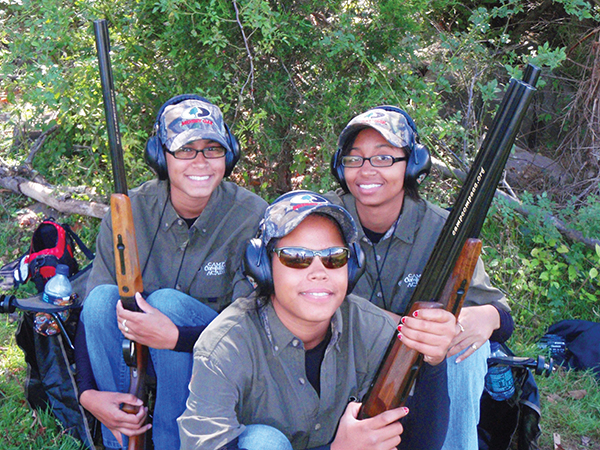Investing In The Next Generation
How The Firearms Industry Can Better Support
Youth Shooting Sports Organizations
As the firearms industry continues to be attacked on what seems like nearly every front possible, and spending and participation in hunting and shooting sports return to pre-pandemic levels, our future hangs in the balance. Investing in future generations is the only way to preserve our legacy and heritage.
In 2016, the Scholastic Shooting Sports Foundation reported participation in youth shooting sport events increased by 142% over the previous 6 years. However, more recent data from the National Sporting Goods Association (NSGA) offers a different perspective. The 2023 edition of its annual U.S. Sports Participation Report revealed the shooting segment showed slight declines compared to the previous year, as a slight increase in hunting with firearms was not enough to offset the decline in the other activities tracked in this segment. These segments include archery (target), archery (hunting), muzzleloading, paintball and target shooting (both live ammunition and airgun).
When it comes to youth involvement in shooting sports, recruitment, retention and reactivation (R3) are the responsibility of every individual and business in the firearms community. Here are some things you can do:
1. Educate
While critics may argue our efforts amount to indoctrination, in reality, cultivating youth involvement in shooting sports helps develop strong character, teach invaluable life skills and open the door to future opportunities.
Similar to other youth sports, participation in shooting sports can help children and teens improve their focus and concentration, hand-eye coordination and motor skills, self-control and emotional regulation, mental focus and problem-solving and discipline, among other skills. Additionally, it helps teach social skills such as teamwork, camaraderie and sportsmanship, as well as responsibility. The only difference is instead of a bat or a ball, their equipment includes firearms and ammunition.
The shooting sports can also serve as a pathway to higher education. Many universities and colleges in the United States offer shooting programs and scholarships for talented athletes. Various shooting associations, foundations, corporations and state and local organization also offer scholarships specifically for youth involved in shooting sports. It’s not uncommon for career opportunities to arise through building relationships with these organizations.
As a range or retailer, you can help educate others on the countless benefits of participating in youth shooting sports. Some ideas include inviting local teams for an exhibition match to help raise awareness. Or, if you don’t have a range, consider hosting a parent information night where families can learn more about the various opportunities in your area.
2. Donate
The most significant challenge impacting youth participation in the shooting sports is too many barriers to access, particularly for those from low-income households or living in urban areas.
Brittany French, CEO of Pass It On — Outdoor Mentors said not having access, not having the confidence and/or skill set and not having anyone to go with are the most common barriers.
“We already knew this about hunting and fishing, but have found the same to be true of shooting sports,” she said.
In an effort to help break down these barriers, Pass It On — Outdoor Mentors founded the Wichita Clay Dusters Shooting Sports Team in 2021. The intramural team is part the Scholastic Clay Target Program (SCTP) and operates independently of the local school system.
“The majority of our team are kids who have never shot a gun and are from a diverse population,” said French. “Part of our recruitment for this team was to make an effort to engage a diverse audience because they face more barriers to outdoor recreation than others.”
To do so, the organization partnered with the leaders of several Black churches in the inner city of Wichita, Kansas, some of whom serve as mentors themselves or provide group transportation to and from their churches for participants.
Not having access can mean a variety of things, from not having access to a range or outdoor recreation area to not having transportation, financial means or access to a firearm or other necessary gear.
Being keenly aware of these barriers, the Wichita Clay Dusters team keeps the cost of joining to $25 per athlete for each 12-week season. The actual cost per athlete to participate is around $320; the difference is subsidized by sponsorships and fundraising efforts.
Individuals and businesses in the firearms community can support shooting sports teams not only with monetary donations, but by donating equipment like targets, ammunition, personal protective equipment or even firearms. Those with a suitable facility may also consider donating range time for weekly practices or competitions.
Perhaps more valuable than money or equipment is your time. Most youth shooting sports organizations are led by volunteers. Consider serving as a mentor.
Your voice is as valuable as your pockets. And if we as an industry don’t collectively utilize every available avenue to support youth involvement in shooting sports, we can kiss our future goodbye.
3. Ask, Don’t Tell
However you decide to get involved, John Annoni, career educator, gun rights advocate and outdoor mentor, encourages those in the firearms community to first decide how far they want to go.
“Are you willing to dig deep and do the hard work? Or is it about sticking to the surface and doing just enough so you can check a box and feel good about yourself?,” Annoni asked. “Do a sincere gut check.”
Annoni also stressed the industry’s need to flip the current model on its head.
“The industry is used to people looking for donations or handouts, but instead of waiting for the ask why not say ‘we’re going to go to you and offer support in whatever way you need it,’” he said. “The burden shouldn’t be on the smaller fish to ask the bigger fish for help when the bigger fish is the one with all the power, leverage and resources.”
Based on the needs he saw as a public school teacher, Annoni founded Camp Compass Academy in 1994 — an organization with the mission to introduce urban, middle and high school students to various outdoor activities including hunting and archery.
In his experience running Camp Compass Academy, he’s realized there isn’t necessarily a shortage of people in the firearms community who are willing or able to help support youth programs: the problem is their support is often contingent upon meeting rigid stipulations and requirements. The result is a failure of the support provided to meet the actual needs.
“The industry can’t tell these organizations what they need, they need to listen to what the actual needs are,” said Annoni. “Instead of saying ‘We’ll give you $5,000 but you can only use it for XYZ,’ imagine the difference it would make if they said, ‘We have $5,000 to give your organization; tell us what you need.’”
4. Advocate
Lastly, a completely free way for those in the firearms community to help grow youth participation in shooting sports is to simply be an advocate.
Proponents of anti-gun legislation will say they want to save lives, particularly the lives of school-aged children. What they fail to consider is how these measures, whether intentionally or not, often rob our youth of the invaluable opportunities previously mentioned.
For example, in May, the Oregon House of Representatives passed HB 2005. The bill contains a myriad of new firearm regulations and specifically threatens youth hunting and high school trap shooting sports by preventing minors from accessing certain commonly owned firearms, even when fully trained in gun safety, supervised by trained adults or participating in lawful and permitted hunting or sport shooting events.
In 2022, California passed AB-2571, which targets firearms advertising to minors with provisions such as prohibiting the use of: “images or depictions of minors in advertising and marketing materials to depict the use of firearm-related products.”
Each violation of the provisions carries a civil penalty of up to $25,000, which forced organizations like the California Youth Shooting Sports Association to cease operations until they could get clarity on how the bill applied to them.
As you become aware of these legislative efforts, contact your representatives to share the success stories of the children and teens who participate in shooting sports organizations. Advocacy can occur at the local level as well. Is your local high school’s archery team on the chopping block? Show up to the school board meeting to voice your support.
The point here: your voice is as valuable as your pockets. And if we as an industry don’t collectively utilize every available avenue to support youth involvement in shooting sports, we can kiss our future goodbye.







